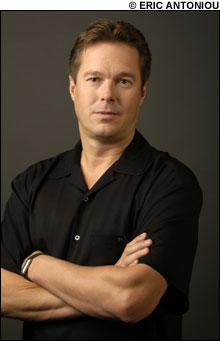
Mikko Nissinen |
It’s been quite a year for Boston Ballet. The company downsized — temporarily, it hopes — by nine dancers. Executive director Valerie Wilder left in March and turned up as director of the Australian Ballet in April. And then the decision was made to move — starting in 2009 — from the Wang Theatre to the Opera House. On the eve of its season-ending “Three Masterpieces” — George Balanchine’s Concerto Barocco (set to Bach’s Double Violin Concerto), Antony Tudor’s Dark Elegies (set to Mahler’s Kindertotenlieder), and Twyla Tharp’s In the Upper Room (set to Philip Glass) — BB artistic director Mikko Nissinen reflects on that program and on the company’s status as a big fish trying to survive in a relatively small pond.How would react if the Boston Ballet board asked you to be the company’s executive director as well as its artistic director?
They’ve already done it. But I think that for the best interests of this organization, we need an excellent executive director. I could do a very good job. But there’s not enough hours in the day to do the artistic director’s job. I’m responsible for the largest school in North America. I have 50 trustees, all 50 overseers, fundraising — I never get to everything I should get to in a single day as an AD. The ED plate is equally impossible. So the answer would be a double madness. I have been pulled already way too much away from the studio over the past several years, and I want to return to the studio and work with the dancers. Lots of dancers came here to work with the repertoire and work with me, and I feel that we’ve had turbulent times and I want to go and help the organization as much as possible when it was most needed. I do start to see the sun rise, and this is the time to return to my original duties. I feel like the first circle has been completed. We’ve started to change the company, and we’ve completed the circle. Now it’s time for round two. While we’re taking one step back, it is with the intention that it is two to three steps forward. So now I will create the next phase of the company. And in the last three months we’ve had tremendous success with fundraising, up and above any of our annual lines, as of today we have over $5 million that will help us with our cash-flow issues, pay down some of the debt, will help us to move to the Opera House, including the renovation of the orchestra pit. This is just in the last three short months. And I want to keep this initiative alive much longer to take care of many things, and then start looking at the company’s 50th anniversary, in 2013. And most likely continue building the fiscal structure. If you have foundation that can support a two-story house and my dream is to build a skyscraper, it would be irresponsible to do it on a foundation that can’t support it. So right now I have been trying to work on the infrastructure, and we will work to create the right financial platform to fulfill our need and do what we intend to do.
Valerie Wilder told the National Post of Canada that, before coming to Boston Ballet, she’d been told that “the board is famous for eating its young.” What’s that all about?
You would be surprised what I was told when I got here. People told me, “You can only do this kind of ballet,” and that’s not the case.
Boston Ballet has always done all sorts of dance.
Exactly.
Over the past 20 years, Boston Ballet has done Balanchine’s Serenade well and his Concerto Barocco not so well. Why might that be?
I have danced in several different companies, and I do see that certain ballets fit certain companies better than others. And it is not always directly related to the quality of the company. When I was in San Francisco Ballet, some of the Balanchine ballets fit like a glove. Ballo della Regina was brilliant, vibrant. Then Symphony in C didn’t seem to fit as well. And they did [Stravinsky] Violin Concerto much better than Four Temperaments. There’s no reason. At Boston Ballet, I held off from Serenade for a long time, because I said I don’t want to just do Serenade, everybody does Serenade, let’s do Serenade when we’re going to do it brilliantly. You haven’t seen Theme and Variations — I love that ballet, but I’ll bring it when I have the right people. And now it’s time for Barocco. I love that ballet. Let’s see.